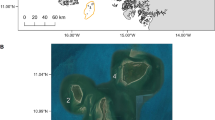Summary
We explore the demographic consequences of site selection by animals on their abundance among habitats. We found that pre and post settling survivorship are important links between the behavioral decisions where to settle and the distribution of a population among habitats. This was demonstrated for 10 generations of the desert isopod, Hemilepistus reaumuri, in three habitats in the Negev Desert, Israel. The populations exhibit low survivorship before settling (≈12%) and high survivorship (≈55%) after settling. According to our model this implies high site selection. Theoretical considerations and the case study led us to suggest the following relationship among settling, demography and habitat selection: 1) Individuals search for suitable settling sites to inhabit and reproduce. 2) Their decision where and when to settle is a cost benefit decision. They weigh the benefit of searching for a high quality site against mortality due to increased searching time. 3) The individual's decision to settle determines the pre and post settling survivorship pattern. 4) Survivorship pattern dictates density pattern in time and space. 5) Density pattern in a given habitat determines its quality for the individual. 6) Settling selection among habitats and the number of safe sites controls the distribution of densities among habitats.
Similar content being viewed by others
References
Abramsky Z, Rosenzweig M, Brand S (1984) Habitat selection of Israel desert rodents: Comparison of a traditional and a new method of analysis. Oikos 45:79–88
Brockmann HJ (1979) Nest site selection in the great golden digger wasp, Sphex ichneumoneus L. (Sphecidae). Ecol Entomol 4:211–224
Coenen-Stass D (1981) Some aspects of the water balance of two desert woodlice, Hemilepistus aphganicus and Hemilepistus reaumuri (Crustacea, Isopoda, Oniscoidea). Comp Biochem Physiol 70A:405–419
Danin A (1972) Mediterranean clements in rocks of the Negev and Sinai Deserts. Notes R Bot Gardens Edinborough 31:29–49
Evenari M, Shanan L, Tadmor N (1983) The Negev: The Challenge of A Desert. Oxford University Press, London
Fretwell SD (1972) Populations in changing environments. Princeton University Press. Princeton, New Jersey
Harper JL (1961) Approaches to the study of plant competition. In: Malthorpe FL (ed), Mechanisms in Biological Competition. Symposium Society for Experimental Biology 15. Cambridge University Press, pp 1–39
McKay TFC, Doyle RW (1978) An ecological genetic analysis of the settling behavior of a marine polychaete I. Probability of settlement and gregarious behavior. Heredity 40:1–12
Murray BG Jr (1967) Dispersal in vertebrates. Ecology 48:975–978
Partridge L (1976) Field and laboratory observations on the foraging and feeding techniques of blue tits (Parus caeruleus) and coal tits (Parus ater) in relation to their habitats. Anim Behav 24:534–544
Rosenzweig ML (1981) A theory of habitat selection. Ecology 62:1051–1069
Rosenzweig ML, Abramsky Z (1985) Detecting density dependent habitat selection. Am Nat 126:405–417
Shachak M (1980) Energy allocation and life history strategy of the desert isopod, Hemilepistus reaumuri. Oecologia 45:404–413
Shachak M, Brand S (1983) The relationship between sit and wait foraging strategy and dispersal in the desert scorpion, Scorpio maurus Palmatus. Oecologia 60:371–377
Shachak M, Chapman EA, Steinberger Y (1976) Feeding, energy flow and soil turnover in the desert isopod, Hemilepistus reaumuri. Oecologia 24:57–69
Shachak M, Newton P (1985) The relationship between brood care and environmental unpredictability in the desert isopod, Hemilepistus reaumuri. J Ar Envir 9:199–209
Shachak M, Steinberger Y, Orr Y (1979) Phenology, activity and regulation of radiation load in the desert isopod, Hemilepistus reaumuri. Oecologia 40:133–140
Shachak M, Yair A (1984) Population dynamics and the role of Hemilepistus reaumuri in a desert ecosystem. In: Sutton SL, Holdich DM (eds) The Biology of Terrestrial Isopods. Symposium of the Zoological Society of London 53:295–314. Oxford Science Publications, pp 295–314
Waser PM (1985) Does competition drive dispersal. Ecology 66:1170–1175
Whitham TG (1979) Habitat selection by Pemphigus aphids in response to resource limitation and competition. Ecology 59:1164–1176
Yair A, Danin A (1980) Spatial variation in vegetation as related to soil moisture regime over an arid limestone hillside, northern Negev, Israel. Oecologia 47:83–88
Yair A, Shachak M (1982) A case study of energy, water and soil flow chains in an arid ecosystem. Oecologia 54:389–397
Author information
Authors and Affiliations
Rights and permissions
About this article
Cite this article
Shachak, M., Brand, S. Relationship among settling, demography and habitat selection: an approach and a case study. Oecologia 76, 620–626 (1988). https://doi.org/10.1007/BF00397879
Received:
Issue Date:
DOI: https://doi.org/10.1007/BF00397879




